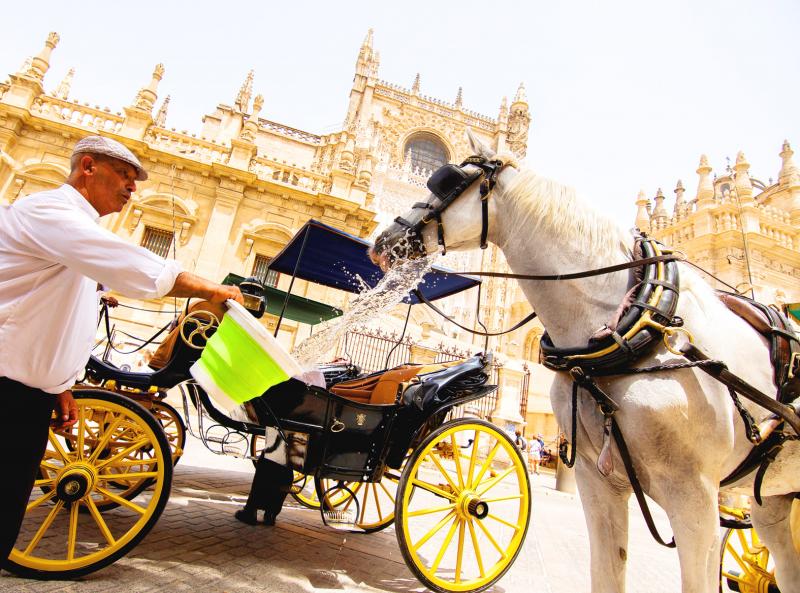For almost 500 years, the arch that connects the largest Gothic cathedral in the world with its Renaissance sacristy has offered visitors a sumptuous, if little glimpsed — and even less studied — vision of religious bounty.
The 68 beautifully carved plates of food that adorn the archway in Seville’s cathedral offer rather more than bread and wine.
There are pigs’ trotters and wild strawberries, aubergines, clams and oysters. There are peaches, radishes, a skinned hare with a knife by its side, a squirrel served on a bed of hazelnuts and a plate of lemons across which a small snake slithers. There are also cakes and biscuits, and, more exotically, a dish of peppers newly imported from Mexico, which had fallen to Hernan Cortes and his men just over a decade before the carvers set to work.

Photo: EPA-EFE
The plates, which are all too often obscured when the huge wooden doors of the sacristy are open, are the subject of a new book by a Spanish art historian who has spent the past 11 years trying to unpick the secrets and meanings of the cathedral’s stone buffet.
“People don’t really see the carvings because of the doors and because they’re too busy looking at the sacristy dome, but the carvings have been there for 500 years and have never been properly studied,” Juan Clemente Rodriguez Estevez said. “They’ve gone unnoticed apart from being seen as a bit of a novelty.”
The arch, which was carved between 1533 and 1535, provides what Rodriguez calls a “snapshot of a seminal moment.”
Its still-life carvings are chapters in the social, religious, economic and cultural history of Seville and Spain as a whole, he said.
The Americas were a fresh and lucrative discovery, the end of the seven-century Reconquista, which culminated in the expulsion of the Jews, was a mere four decades distant, and the Reformation was sweeping Europe.
Contemporary theologians and mystics focused on the importance of the eucharist and sought to portray communion as “a great feast to which everyone was invited,” said Rodriguez, who teaches at the University of Seville.
His book, The Universal Banquet: Art and Food in Renaissance Seville, examines how food was used to strengthen Catholic identity, employed as an image of the abundant joys of the afterlife, and even deployed as a bridge between Europe and the Americas.
Pork, unsurprisingly, features three times among the 68 plates, but olive oil — a staple of Andalucia since Roman times — is curiously absent. Rodriguez’s theory is that it might have been left out on the orders of Baltasar del Rio, a bishop who was instrumental in the arch’s creation.
Despite making a name for himself in the church in both Rome and Seville, Del Rio was from a family of conversos — Jewish converts to Catholicism — and his father was judged by the Inquisition at the end of the 15th century.
Mindful of his roots, the bishop might have chosen to exclude oil because it was used by Jews, who like Muslims — but unlike Catholics — did not fry their food in pig fat.
“Being a converso, Del Rio would have had to be very careful about the foods that were represented in the arch. They all needed to be really Catholic, but there are some foods that have a Jewish influence, such as the aubergines,” Rodriguez said. “Aubergines came to Europe through Islam, and came to be prized by Muslims and Jews alike. I think the presence of aubergines shows how normalized they had become by then.”
The bread at the center of the arch could also be a reference to Del Rio’s decision to found a brotherhood to help feed Seville’s poor.
“There was a terrible famine in 1521 and he ordered cheap wheat to be bought so that the poor would be provided with bread when wheat prices rose. If you look at the middle of the arch, you can see the loaves of bread,” Rodriguez said.
The peppers, which he had taken for strawberries until one of the botanists he consulted set him straight, are the only crop from the Americas.
“There aren’t more foods from there because it was still early days,” he said. “At that time, corn was mainly used as animal feed and the potato hadn’t arrived in Spain because the conquest of Peru took place in the 1530s, so the ships from Peru were only beginning to arrive.”
The traffic was not all one way.
The Augustinian friars who followed the Dominicans and the Franciscans to the Americas built three churches in Mexico in the 1560s whose doorways were decorated with plates of food, Rodriguez said.
The aim was to celebrate the eucharist and to help explain the importance of communion to a conquered people who were not familiar with bread and wine.
Rodriguez is delighted with the fruit of his more than a decade’s research, and keen to stress that he owes a huge debt to the botanists, zoologists and other experts he consulted on his physical and intellectual travels.
“I couldn’t have written the book if it wasn’t for the decades of work by researchers who have helped us understand food in a cultural context,” he said. “All I would have seen was a load of plates. When I started looking at the arch, I saw a window on to the 16th century, but I wasn’t quite sure what was on the other side.”

TURNAROUND: The Liberal Party had trailed the Conservatives by a wide margin, but that was before Trump threatened to make Canada the US’ 51st state Canada’s ruling Liberals, who a few weeks ago looked certain to lose an election this year, are mounting a major comeback amid the threat of US tariffs and are tied with their rival Conservatives, according to three new polls. An Ipsos survey released late on Tuesday showed that the left-leaning Liberals have 38 percent public support and the official opposition center-right Conservatives have 36 percent. The Liberals have overturned a 26-point deficit in six weeks, and run advertisements comparing the Conservative leader to Trump. The Conservative strategy had long been to attack unpopular Canadian Prime Minister Justin Trudeau, but last month he

OPTIMISTIC: A Philippine Air Force spokeswoman said the military believed the crew were safe and were hopeful that they and the jet would be recovered A Philippine Air Force FA-50 jet and its two-person crew are missing after flying in support of ground forces fighting communist rebels in the southern Mindanao region, a military official said yesterday. Philippine Air Force spokeswoman Colonel Consuelo Castillo said the jet was flying “over land” on the way to its target area when it went missing during a “tactical night operation in support of our ground troops.” While she declined to provide mission specifics, Philippine Army spokesman Colonel Louie Dema-ala confirmed that the missing FA-50 was part of a squadron sent “to provide air support” to troops fighting communist rebels in

PROBE: Last week, Romanian prosecutors launched a criminal investigation against presidential candidate Calin Georgescu accusing him of supporting fascist groups Tens of thousands of protesters gathered in Romania’s capital on Saturday in the latest anti-government demonstration by far-right groups after a top court canceled a presidential election in the EU country last year. Protesters converged in front of the government building in Bucharest, waving Romania’s tricolor flags and chanting slogans such as “down with the government” and “thieves.” Many expressed support for Calin Georgescu, who emerged as the frontrunner in December’s canceled election, and demanded they be resumed from the second round. George Simion, the leader of the far-right Alliance for the Unity of Romanians (AUR), which organized the protest,

ECONOMIC DISTORTION? The US commerce secretary’s remarks echoed Elon Musk’s arguments that spending by the government does not create value for the economy US Secretary of Commerce Howard Lutnick on Sunday said that government spending could be separated from GDP reports, in response to questions about whether the spending cuts pushed by Elon Musk’s Department of Government Efficiency could possibly cause an economic downturn. “You know that governments historically have messed with GDP,” Lutnick said on Fox News Channel’s Sunday Morning Futures. “They count government spending as part of GDP. So I’m going to separate those two and make it transparent.” Doing so could potentially complicate or distort a fundamental measure of the US economy’s health. Government spending is traditionally included in the GDP because